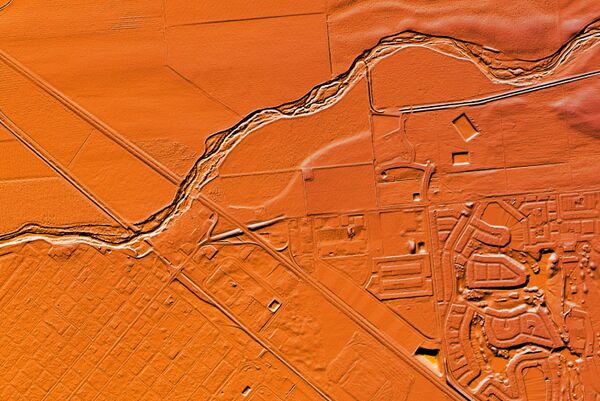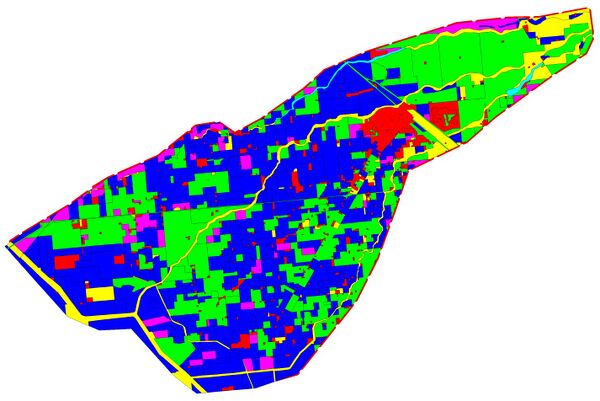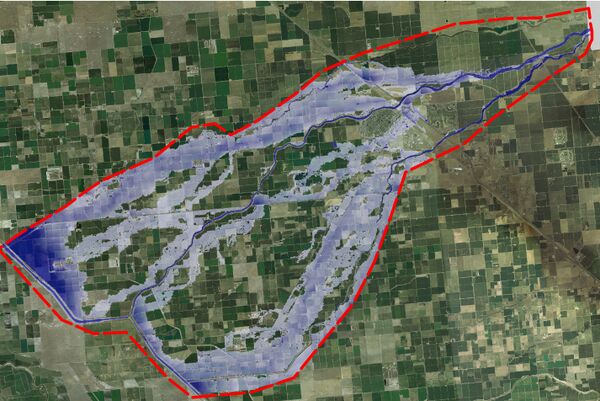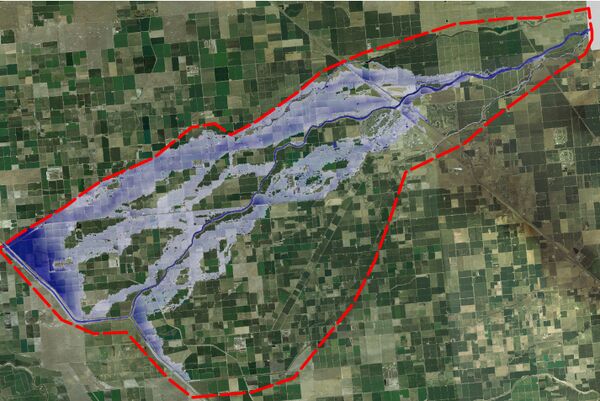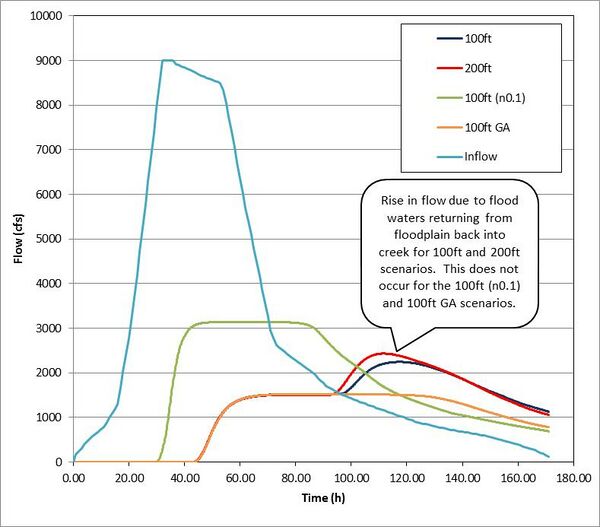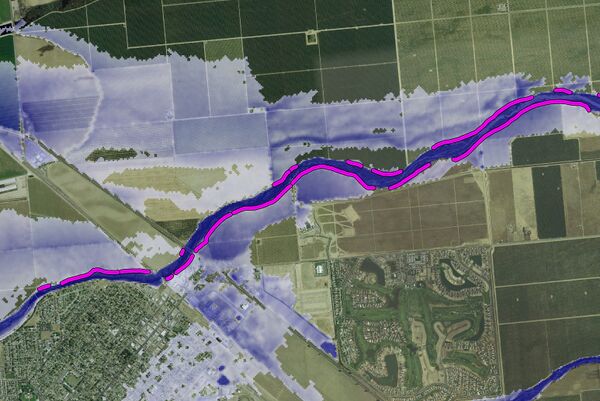FMA Challenge 3
Introduction
If you haven't already completed FMA Challenge 2, please see this FMA Challenge 2 page. This page is for TUFLOW users of intermediate to advanced ability.
In this challenge, a typical non-urban stream of the California Central Valley will be explored. The stream originates near the Sierra Nevada Foothills and conveys runoff to the West into the Central Valley Flood Management System. The streams are natural, with large amounts of conveyance in their upper reaches. As the streams progress downstream, their conveyance capacity gradually reduces. At some point nearing the valley floor, typical levees have been constructed to contain normal floods within the conveyance systems.
From this challenge, it is expected the user will develop their skills in:
- Understanding of the influence of levees on flood behaviour;
- Understanding of the influence of infiltration on flood behaviour;
- Nested 1D/2D models; and
- Understanding the Green and Ampt infiltration method and USDR soil types.
Data for this model is provided via external hard drive or DVD.
Relevant Tutorials
It may be useful to revisit some of the following tutorials:
- 1D-2D Linking- Tutorial Module 2
- Running Events and Scenarios- http://www.tuflow.com/forum/index.php?showtopic=1149&hl=scenario
Information to Modelers
Assignment of all parameters for this analysis are at the discretion of the modeler. A high resolution aerial image is provided so that land cover details can be inspected. Information on the problem definition can be found on FMA_Challenge_Models/FMA_Scenario3/FMA_Challenge_Model_Introductions.
Relevant Files
It is up to the modeler's discretion to determine what GIS package to use, what text editor to use, and how to run their models (batch mode or within the text editor).All relevant files can be found on FMA_Challenge_Models/FMA_Scenario3/
Solution
A sample solution has been presented, courtesy of BMT WBM.
Cross Section Spacing, Grid Size, Mesh Element Size, and Effects of Hydraulic Structures
The model was set up as a TUFLOW 1D/2D model. Two different resolutions for the floodplain were simulated using 100ft and 200ft cell sizes.
1D sections spacing were generally between 500ft and 1000ft (except at structures). Structures were modeled with additional energy loss, to simplify the model a value of 1.0 V2/2g was used for all structures in the main creek.
Linking between 1D/2D was along the top of the levees.
All outflow from the model was assumed to be only via the main creek (ie. there was no water level boundary applied to the 2D overbank domain).
The number of cross sections, grids, or mesh elements used were as follows:
| 2D Cell Size | Active 2D Cells |
|---|---|
| 100ft | 338, 020 |
| 200ft | 84, 818 |
Computational Domain Assembly and Execution
The provided DEM via GMG format was too coarse for hydraulic modeling as key hydraulic features (such as levee crests) were not adequately represented. The first step was therefore to process the 20Gb of LiDAR data into a higher resolution DEM. A 10ft DEM was created, a small part of which is illustrated below.
Cross-sections were extracted from the 10ft DEM, with Manning’s n values extracted from the provided GIS land use layer shown in the image below.
The Manning’s n values adopted were as provided and are tabulated below with comments on their applicability.
| Apparent Land Use | Manning's n | Colour (in image above) | Comment |
|---|---|---|---|
| Urban Areas | 0.04 | Red | Acceptable value when representing the combination of roads (0.02) and buildings, gardens and fences (0.08 to 0.30), especially if the roads are wide. |
| Cropping/Cultivation | 0.10 | Green | Representative of established medium density crops. |
| Cropping/Cultivation | 0.12 | Blue | Representative of established medium to high density crops. |
| Cropping/Cultivation | 0.15 | Magenta | Representative of established high density crops. |
| Creek | 0.20 | Yellow | Would consider this value very high. A quick inspection of the creek photos taken near structures would indicate that maybe in the upper reaches where there seems to be reasonably dense vegetation in the creek that this value is representative, but even so we still consider this value to be high in this case. In the lower reaches the creek seems quite open with little vegetation (more representative of an n value from 0.04 to 0.08). |
| Creek | 0.25 | Cyan | See comment above. |
The 1d/2d linking was along the top of the levee. The elevations along these levees were extracted from the 10ft DEM, these and other significant features were included in the TUFLOW model as 3D GIS breakline layers, ensuring the hydraulic control is represented in the grid regardless of cell size.
The flood extent from the 100ft 2D grid model is shown below.
===Sensitivity Creek Manning's n Test (Scenario 100ft n0.1) As discussed in the Manning’s n table above, the main creek n value of 0.20 is considered very high, especially in the lower reaches of the study area. A sensitivity analysis was carried out by lowering all the Manning’s n values in the main channel (modeled as 1D cross-sections) to 0.10.
The image below shows the flood depths and extent, and the outflow is included in the ftp download. Of particular interest is that reducing the n value to 0.1 has a significant effect on the arrival time of the flood waters at the model outlet (much earlier), and reduces the volume of water flowing onto the floodplain by around 20% due to the higher conveyance of the creek. Also of interest is that for the n=0.2 scenario, some overbank floodwaters return to the main creek near the model outlet causing a delayed second rise in the outlet flow hydrographs as illustrated in the chart further below. This effect does not occur for the n=0.1 scenario, with all overbank floodwaters remaining on the floodplain.
The sections of levee that were overtopped were post-processed using GIS for the 100ft with n=0.2 scenario as illustrated by the magenta lines in the image below. The GIS layer showing the overtopped sections is provided as part of the ftp download.
Conclusion
In this challenge, we explored typical non-urban stream of the California Central Valley, with scenarios of various infiltration and flood levees adopted. From this, we gained a better understanding of the influence of flood levees on surface water behaviour, understanding of the Green Ampt infiltration method and USDR soil types, and a better understanding of nested 1D/2D models.
Congratulations on finishing Challenge 3!
